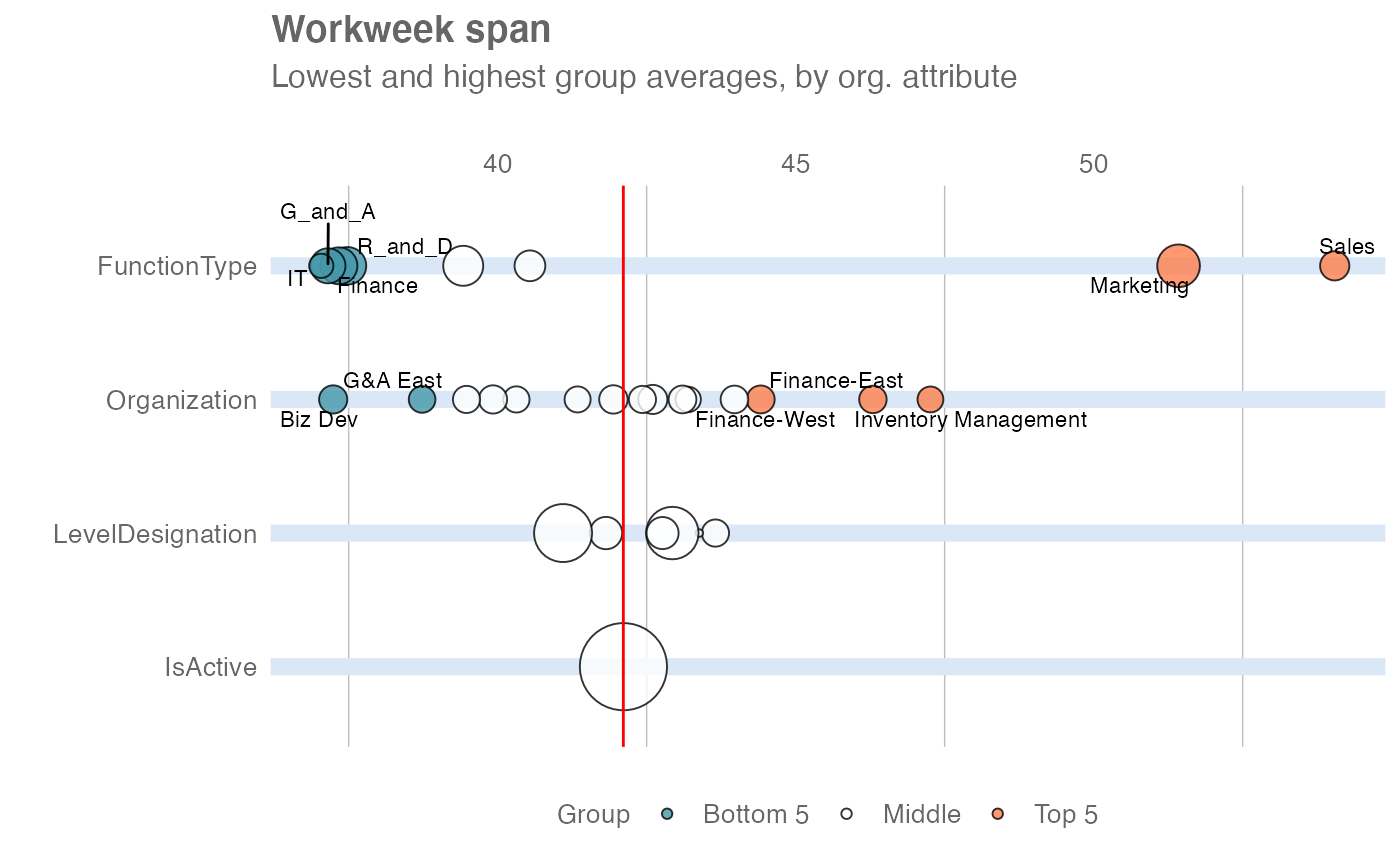Rank all groups across HR attributes for Work Week Span
Source:R/workloads_rank.R
workloads_rank.RdThis function scans a standard query output for groups with high levels of Work Week Span. Returns a plot by default, with an option to return a table with a all of groups (across multiple HR attributes) ranked by work week span.
workloads_rank(
data,
hrvar = extract_hr(data),
mingroup = 5,
mode = "simple",
plot_mode = 1,
return = "table"
)Arguments
- data
A Standard Person Query dataset in the form of a data frame.
- hrvar
String containing the name of the HR Variable by which to split metrics. Defaults to
"Organization". To run the analysis on the total instead of splitting by an HR attribute, supplyNULL(without quotes).- mingroup
Numeric value setting the privacy threshold / minimum group size. Defaults to 5.
- mode
String to specify calculation mode. Must be either:
"simple""combine"
- plot_mode
Numeric vector to determine which plot mode to return. Must be either
1or2, and is only used whenreturn = "plot".1: Top and bottom five groups across the data population are highlighted2: Top and bottom groups per organizational attribute are highlighted
- return
String specifying what to return. This must be one of the following strings:
"plot"(default)"table"
See
Valuefor more information.
Value
A different output is returned depending on the value passed to the return
argument:
"plot": 'ggplot' object. A bubble plot where the x-axis represents the metric, the y-axis represents the HR attributes, and the size of the bubbles represent the size of the organizations. Note that there is no plot output ifmodeis set to"combine"."table": data frame. A summary table for the metric.
Details
Uses the metric Workweek_span.
See create_rank() for applying the same analysis to a different metric.
See also
Other Visualization:
afterhours_dist(),
afterhours_fizz(),
afterhours_line(),
afterhours_rank(),
afterhours_summary(),
afterhours_trend(),
collaboration_area(),
collaboration_dist(),
collaboration_fizz(),
collaboration_line(),
collaboration_rank(),
collaboration_sum(),
collaboration_trend(),
create_bar(),
create_bar_asis(),
create_boxplot(),
create_bubble(),
create_dist(),
create_fizz(),
create_inc(),
create_line(),
create_line_asis(),
create_period_scatter(),
create_rank(),
create_sankey(),
create_scatter(),
create_stacked(),
create_tracking(),
create_trend(),
email_dist(),
email_fizz(),
email_line(),
email_rank(),
email_summary(),
email_trend(),
external_dist(),
external_fizz(),
external_line(),
external_network_plot(),
external_rank(),
external_sum(),
hr_trend(),
hrvar_count(),
hrvar_trend(),
internal_network_plot(),
keymetrics_scan(),
meeting_dist(),
meeting_fizz(),
meeting_line(),
meeting_quality(),
meeting_rank(),
meeting_summary(),
meeting_trend(),
meetingtype_dist(),
meetingtype_dist_ca(),
meetingtype_dist_mt(),
meetingtype_summary(),
mgrcoatt_dist(),
mgrrel_matrix(),
one2one_dist(),
one2one_fizz(),
one2one_freq(),
one2one_line(),
one2one_rank(),
one2one_sum(),
one2one_trend(),
period_change(),
workloads_dist(),
workloads_fizz(),
workloads_line(),
workloads_summary(),
workloads_trend(),
workpatterns_area(),
workpatterns_rank()
Other Workweek Span:
workloads_dist(),
workloads_fizz(),
workloads_line(),
workloads_summary(),
workloads_trend()
Examples
# Return rank table
workloads_rank(
data = sq_data,
return = "table"
)
#> # A tibble: 18 × 4
#> hrvar group Workweek_span n
#> <chr> <chr> <dbl> <int>
#> 1 FunctionType Sales 52.4 66
#> 2 FunctionType Marketing 52.1 125
#> 3 LevelDesignation Manager 44.1 200
#> 4 Organization Human Resources 44.0 71
#> 5 LevelDesignation Senior IC 43.9 67
#> 6 Organization Finance 43.6 292
#> 7 LevelDesignation Director 42.8 43
#> 8 LevelDesignation Junior IC 42.5 58
#> 9 Organization IT 41.8 130
#> 10 Organization Customer Service 41.6 61
#> 11 LevelDesignation Support 41.3 257
#> 12 FunctionType Engineering 41.1 49
#> 13 Organization Financial Planning 40.1 75
#> 14 FunctionType Operations 39.8 115
#> 15 FunctionType R_and_D 38.1 74
#> 16 FunctionType IT 37.4 22
#> 17 FunctionType Finance 37.4 74
#> 18 FunctionType G_and_A 37.2 104
# Return plot
workloads_rank(
data = sq_data,
return = "plot"
)
